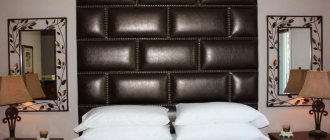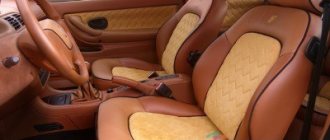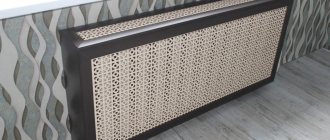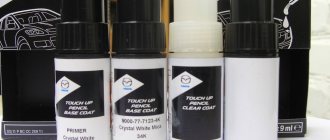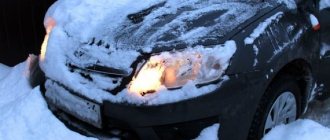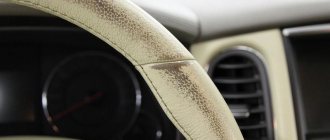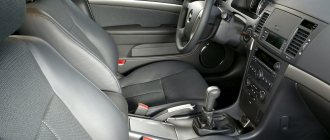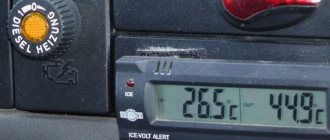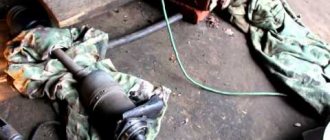Types of Dents
Before you straighten a dent on your car with your own hands, you need to know what types of damage exist. Dents on a car have different shapes and degrees of damage. Small defects usually appear on the roof and hood of the car due to hail and small stones. Medium and large metal fractures are a direct result of careless driving. Such dents on the car body can have a complex shape.
If the paint at the site of a large crease becomes cracked and begins to fall off, then, in addition to removing the dent, you will need to restore the paintwork. Otherwise, pockets of corrosion will form on the part of the body where the damage occurred.
Helpful information
Car body repair involves performing a varied number of works depending on the degree of damage to the car, the desires and financial capabilities of the owner to restore the original appearance of his car. In the current situation, when on the one hand there is the car owner and his desire to save money, and on the other there is a large number of different car repair services, it is very difficult to understand in advance whether the selected service will fulfill its obligations for body repair. Repairing a car body in accordance with technological requirements requires, in addition to the high skill of specialists, the availability of appropriate equipment.
Restoring a car body is a complex process that results in a refurbished body that matches factory dimensions with parts painted the same color. To carry out such a labor-intensive and technically complex process, the service center requires special equipment: stocks, measuring and control systems, welding equipment, a paint booth, etc. Let's see what equipment is used at various stages of body repair.
Straightening
High-quality repair of minor damage and dents of a car requires a fairly wide range of tools for straightening and cleaning surfaces. In the process, orbital and belt sanders are used. Orbital machines in combination with abrasives allow you to remove the top layer of paint. If vacuum straightening of the body is used, in many cases it is necessary, if not painting, then polishing the car with abrasive and finishing compounds. For difficult cases when it is necessary to quickly remove a layer of paint, eccentric sanders are used. The Volga-Rast body repair center uses equipment from Wielander+Schill, which is the official supplier of many of the world's leading automakers. The German company Wielander+Schill has been developing and producing professional equipment and tools for body repair for more than 40 years.
Car body stretching
To correct damage associated with deformation of the car body, special robotic stands will be used. The electronic measurement system built into such stands tracks the geometry of the car body at control points. The car body has measurement points that are unique to each model. The electronic database built into these systems contains information on control points for measuring various machine models. Thanks to this, it is possible to control and, if necessary, correct the body stretching process. The principle of work for pulling the body is based on the application of a calculated force developed by the slipway and power racks to certain places of the car body.
When restoring the geometry of the body, the following stocks are used:
- Platform. In this case, the basis of the slipway is the platform to which the car is attached using special devices. The advantage of such systems is their versatility. Platform stocks allow you to work with defects of any level of complexity: from minor damage to the restoration of a damaged machine frame;
- Frame. These are more complex systems compared to platform ones. The machine is lifted with the help of jacks and fixed on one side on the stand. Frame systems are used only to repair minor damage. For complex repairs, the car body must be rigidly fixed and the straightening force directed in all directions. The use of frame stocks does not allow this to be achieved. This design has a number of advantages. Firstly, it is quite lightweight and allows you to use it on a scissor lift. Thanks to this, specialists can choose the height to which they need to raise the machine so that it is convenient to work with it. Secondly, when using such systems, a large amount of free space is obtained for working under the bottom of the car;
- Floor-standing. This system includes rails that are built into the floor, power racks and a set of anchors, as well as clamps. Light to moderate damage can be repaired on such slipways. The advantage of floor-standing systems is their versatility - the bodies of almost any brand of car can be straightened on them. The disadvantage of such a system is the lack of mobility, because Due to the built-in rails, it cannot be moved. The rails are mounted flush with the floor, so when the slipway is not in use, other repair work can be carried out in this place.
The Volga-Rast company uses professional equipment from Wedge Clamp to restore body geometry. The Canadian company Wedge Clamp has been specializing in the development of professional systems for restoring damaged car geometry since the 80s of the 20th century. The Wedge Clamp exhaust stand will ensure the performance of bodywork of any complexity. The required vector and traction force is achieved through two power devices.
Lifts in body repair
During the initial inspection of the car, when performing body work, it is difficult to do without lifts. In modern services, electro-hydraulic lifts are mainly used. If it is necessary to raise the body to a small height, then rolling jacks are used. When repairing commercial vehicles, rolling columns are used, which simultaneously lift heavy equipment. When straightening and other body work, scissor lifts are most often used, as they are quite compact. In order to free up space in the repair shop, plunger-type lifts can be used, which, when lowered, are completely recessed into the floor.
Painting equipment
Carrying out repairs on a car body requires subsequent painting of the part being repaired. Therefore, the repair shop must have painting kits. They include an extensive list of equipment and tools:
- various grinding and polishing machines to prepare the surface for painting;
- coloring tables and specialized automatic systems for selecting the desired color of the part to be painted. The enamel chosen for painting, in addition to decorative requirements (matching color and gloss), must have such physical and mechanical properties as hardness, elasticity, and strength. The Volga-Rast body repair center uses a professional color matching system from the well-known German company Spies Hecker, which offers a world-famous technology for preparing the desired color from a set of standard components.
- spray guns for local or full body painting;
- drying panels and special painting and drying chambers to maintain the required painting and drying conditions for painted parts or the entire body. In this case, the highest quality result is achieved, which is close to the factory paint job of the car.
welding equipment
Welding work is one of the most difficult operations in the entire complex of body work. This complexity is due to the need to strictly adhere to the technology of the welding process and the specifics of using welding when repairing a car. Welding work in a car service has its own characteristics:
- Craftsmen have to work with thin-sheet automotive steel, aluminum and its alloys;
- In addition to strength, the aesthetic appearance of the seam is important - it should be as inconspicuous as possible;
- The weld seam must be protected from corrosion.
Welding body work can eliminate corrosion damage. Welding is also used when replacing individual body parts. The period of further operation of the machine depends on the quality of the seam.
Because of this, when carrying out body work in car repair shops, the following types of welding machines are used: semi-automatic (MIG/MAG) and spotters. The former ensure good seam quality while maintaining high productivity of the welding work itself. The latter are used to correct deformations of the car body without dismantling.
Professional performance of body repair work involves the use of specialized equipment, in particular, welding complexes. For spot welding on both sides and one side, and for welding metal of various thicknesses, specialists at the Volga-Rast body repair center use the Deca welding complex. The Italian company Deca has held a leading position in sales of welding equipment in Europe and around the world for more than 30 years. Deca welding systems can weld aluminum, titanium and other metals. With the help of professional machines and experienced interior welders, a sealed and invisible weld is obtained, and the integrity of the body geometry is preserved.
The Volga-Rast body repair center offers body repair services for cars of all brands on special terms. Favorable prices for painting and body work on cars of any brand (except domestic and Chinese cars) from 840 rubles/standard hour.
You can find out all the necessary details for body repair of your car and make an appointment for repairs by calling (8442) 55-15-55.
Methods for removing simple dents on a car
Repairs small dents without repainting the damaged area. The defect is corrected using PDR (paintless dent repair) technology, that is, without repainting the part being restored. To perform the work use:
- Magnets. Allows you to repair minor damage to the body. Place a small piece of lint-free cloth under the device.
- Glue applicator, the device is attached to the car body using glue. After the adhesive has dried, the specialist slightly pulls the applicator in his direction, thereby leveling the body crease.
- Suction cups allow you to correct simple defects. The vacuum pulling method removes metal creases formed after small stones, hail and icicles fall into the car.
- A construction hair dryer is used to eliminate defects of various shapes. Blow warm air over the damage, then immediately spray it with cold air from a can.
- Hooks. These devices are useful for pulling out hidden parts. They remove boxes and stampings from hidden areas of the body surface.
- Bumper. It has a cigar shape and is designed to straighten metal that has bent outward.
- Rubber hammer. A rubber backing is installed on the reverse side of the damaged area. Use gentle blows to level the surface. The method of removing dents on a car is applicable to both small and deep defects.
The list of necessary tools also includes a set for leveling defects Pops a Dent. It includes attachments, a plastic bracket, and glue. Repairs are carried out as follows:
- The center of the damaged area is thoroughly degreased.
- Heat the adhesive. To do this, the glue stick is inserted into the gun and connected to the mains.
- The heated composition is applied to a rubber nozzle and glued in a circular motion to the center of the damage.
- After 2-3 minutes, a bracket is attached to the pad.
- Using a thumbscrew, the bracket is screwed onto the nozzle until the defect is eliminated.
- 5 minutes after completion of the work, the device is removed from the body.
The use of special Pops a Dent equipment is advisable if dents often appear on the car body. If defects of this type appear rarely, it will be more profitable to use other damage extraction technologies.
Using a Hot Glue Gun and Pull Tools
This is a controversial method that was invented by home craftsmen. The tool works on the principle of a vacuum suction cup. A vacuum cleaner acts as a pump; the function of a suction cup is played by a flower pot, which is hermetically mounted on the hose.
Using a vacuum cleaner will help straighten the wing without painting with minor unevenness of the metal surface; it can be used as an aid when using cores or levers.
Kits for eliminating body defects, such as Pops-a-Dent, contain a gun, which is used to apply heated glue to the lamb or applicator. When making home repairs, you can use a construction gun and improvised materials, plastic blanks with screws or hooks installed across them.
A simple device will help pull out a dent, both on a metal door and on a plastic part, provided that there is no crack on the polypropylene panel under the paint layer. Step by step process:
- Prepare plastic or wooden logs, up to 5 cm long, with a bottom diameter of 1 cm.
- Screw a self-tapping screw or strong steel wire onto each blank.
- Use a pistol to apply glue to the bottom of the blank.
- Place the block on the dent. If the defect is small, glue one block in the center of the defect, otherwise install several blocks.
- Wait 40 minutes. until the glue dries completely.
- Use your hands to carefully pull the screw, straightening the dent.
- Extraction should be carried out evenly, starting from the perimeter of the defect.
The method is used if there is access to the internal panels. The straightening takes place from the inside of the defect.
- The soccer ball is deflated completely and given a flat shape.
- Install the pump hose onto the rear nipple of the ball and push the ball under the dent.
- They gradually pump it up, this way the metal is straightened from the inside.
- After the defect is eliminated, you need to lower the ball and pull it out of the panel.
It’s easy to straighten out a dent on a fender with your own hands, but it’s better to watch a video tutorial before doing so. Drivers who have never had their car body repaired note that the process can take a long time if the work is done quickly and carelessly.
How to fix a heavy dent with your own hands
To remove the deepest dents, use impact pads of various shapes and hammers. Spoons are used as counterfeit tools. They have different shapes and sizes and are used depending on the type of damage.
The metal in the center of the damage is thinner than at the edges. Before straightening, you need to pull the iron to the center of the defect. A gas burner is used for this. Next, the dents are aligned.
After roughly leveling the defect, it is covered with putty.
Repairing dents with a jack
Using a jack will help you pull out a dent in a car body with your own hands. The device is used to repair deep damage on the wings of a car.
Before carrying out work, dismantle the front turn signal and headlight. On the side of the dent, the jack rests against the heel (a rubber block is first placed under it); the lever of the device should rest against the opposite edge of the opening. The operation is stopped after the defect has been corrected, and the damaged area is covered with putty.
Body stretching by heating
One of the most effective methods for straightening minor damage is to pull back the metal with heating. It is carried out on its own using a welding inverter. Stretching of the metal is carried out after heating the damaged area - this way the material becomes more pliable, it will be easier to avoid the formation of cracks and other defects. Before starting work, a video with an example of such an operation will help you understand the essence of the process. After warming up, a completely standard tool is used for leveling - rubber and metal hammers of different weights. The damaged area is gradually tapped with them to its normal shape.
It should be borne in mind that stretching must be completed in a timely manner, that is, the metal must cool down by the end of the work, otherwise it may deform and again spoil the surface geometry.
Removing dents on a car using a reverse hammer
Straightening dents using a reverse hammer is performed when the driver has difficulty accessing the damage site, or the parts being restored cannot be dismantled. Repairing body dents like this usually requires subsequent painting of the repaired part. To straighten a dent, perform the following steps:
- Clean, dry and degrease the surface to be restored. Remove traces of corrosion.
- One end of the reverse hammer is attached to the center of the damage. The operation is performed using a special suction cup or applicator.
- Straightening is carried out by gradually increasing blows of the weight on the hammer handle.
- After completing the restoration of the exterior of the body, the hammer is disconnected.
An applicator or suction cup is only effective in straightening the body if the damage is not serious. In the presence of deep and complex defects, the hammer is welded to the surface, or clings to technological holes using special hooks.
Pulling out a dent with a plumber's plunger
Correcting a car fender using a plunger has been known for several decades. Many drivers tried this method and in 90% of cases did not get the desired result, because when pumping air out of the rubber base, they pressed on the handle mounted on the body and made the dent even larger. Algorithm for using a plunger for sinks step by step:
- Moisten the surface of the defect.
- Warm up the rubber suction in hot water.
- Apply the edge to the dent, gradually squeezing out the air, and install the plunger on the dent.
- Pull sharply.
After using the plunger, unevenness remains on the part. The wing or doors must be leveled with a rubber hammer and polished at the final stage.
Straightening
The process that allows you to remove a dent on a car and repair a local area of the body is called straightening. The work, if you have some experience and time, is carried out with your own hands according to the following algorithm:
- Wash and dry the work surface.
- Degrease the damage.
- Carrying out body repairs.
Straightening of minor damage can be carried out without subsequent painting of the damaged area. Using reverse hammers, hooks, a hair dryer, suction cups and applicators, and rubber hammers, the defect is eliminated.
If you need to fix a deep dent on a car, accompanied by creases, peeling of the paintwork and metal rupture, then use the following tool:
- Hammer and anvils of various shapes and sizes.
- Spoons.
- Jack.
- File.
- Welding machine.
- Grinding device.
The anvils are applied to the outside of the dent, and from the center, the surface is roughly leveled with gentle blows. Spoons act as a substrate for a percussion instrument, but they are used to eliminate defects that appear in hard-to-reach places. After leveling, inspect the area to be repaired. If there are gaps in the metal, they are welded together. Use a file to remove excess bulges. Next you need to putty the body to level the working surface. The treated area is sanded, coated with primer, painted and polished.
Truck body painting prices
| Name of works and services | Cost, rub. |
| Painting a new bumper | from 3500 |
| Painting a used bumper | from 6500 |
| Name of works and services | Cost, rub. |
| Painting a new front/rear fender | from 4000 |
| Painting a used front/rear fender | from 4500 |
| Painting the front/rear wing with a transition (local painting of the wing) | from 1000/1500 |
| Name of works and services | Cost, rub. |
| Painting a new front/rear door | from 5000 |
| Painting a used front/rear door | from 6000 |
| Painting the front/rear door with a transition (local painting of the door) | from 2500 |
| Name of works and services | Cost, rub. |
| Painting the new hood (both sides) | from 6500 |
| Painting a used hood (both sides) | from 7000 |
| Painting the hood with a transition | from 2500 |
| Name of works and services | Cost, rub. |
| Roof painting | from 9000 |
| Painting the roof with a transition (possible if there is a hatch) | from 2500 |
| Name of works and services | Cost, rub. |
| Painting a new threshold (sill plate) | from 4000 |
| Painting a used threshold (threshold overlay) | from 4500 |
Correct putty
Before you putty the car body with your own hands, you need to prepare. This will help avoid visible defects after painting the car:
- Sand and remove excess metal bulges.
- Degrease and clean the treated surface. In some cases, the operation is performed several times.
- Repair the repaired area of damage by applying putty evenly in several layers.
- After it dries, the surface is sanded. It is important to ensure that the putty layer is flush with the rest of the surface of the car body.
- Apply primer in two layers.
- Paint the surface using a spray gun. Apply varnish and polish the surface.
Replacing a part or part of it
If there is more serious damage, removing dents will not help restore the integrity of the part. In this case, the body element, or its most severely damaged part, is replaced with a new one. When replacing, it is necessary to find a part identical to the one being replaced. If a specific area is being replaced, the patch is cut from the same metal. Next, it is welded to the part being restored.
Minor damage to the body, chips, scratches and dents on the car can be repaired independently without repainting. Parts of the body that were not previously damaged are subject to restoration. If paint cracking, breaks or kinks appear, repairs without painting will not be possible.
Good straightening of a car with your own hands is impossible without special tools and special skills. If the skill comes with time, then the tool needs to be purchased or made independently:
This is a training video on straightening a car wing:
This video shows the process of straightening the roof of the GL 450. The author shows how the roof reinforcement and the upper windshield frame are pulled out:
This is the final video of the master class on straightening the roof of the GL 450:
And finally, straightening a car from our auto industry - VAZ 2108:
The need to carry out work to replace the roof of a car arises when there is a side collision with a tree, fence or solid wall. In addition, such a need manifests itself in the event of a vehicle overturn. The advisability of taking such measures is determined by the scale of the damage. In some cases, standard straightening does not eliminate existing defects, and carrying out this type of work is accompanied by significant financial costs.
Car body exhaust
A specialized service station provides a full range of vehicle services:
- Scheduled check.
- System diagnostics.
- Repair of any complexity.
- Replacement of fuel and lubricants.
Body stretching is a service that is carried out by specialists of our company quickly and efficiently. We have a powerful material and technical base. The service station has a staff of qualified craftsmen with specialized education and experience in the field. Repair work is carried out for domestic and imported cars.
Call us to agree on the timing and cost of the work +7 (343) 344-62-40
How to be
ATTENTION! A completely simple way to reduce fuel consumption has been found! Don't believe me? An auto mechanic with 15 years of experience also didn’t believe it until he tried it. And now he saves 35,000 rubles a year on gasoline! Read more"
Straightening the car roof can only be done if the scale of the damage is not significant. In this case, the layer of interior upholstery and all the seats in the cabin are first removed. This process is carried out using a pushing jack.
It should be emphasized that independent puttying of a large section of the roof is a very labor-intensive process that must be performed by specialized specialists. In this context, completely replacing the car's roof would seem like a more feasible solution.
Carrying out repair work
If the damage to this element of the machine is not serious, repair work can be carried out without dismantling.
First, our specialists conduct a detailed analysis of the damage. The surface is also examined for the safety of the paintwork. If the paintwork is not damaged, then repairs are carried out without further painting.
The procedure is as follows:
- The rear and windshield windows are removed, and the upholstery and decorative trim in the interior are also removed.
- Restore body geometry. The roof stretches quite easily, but there are some nuances. If there are kinks, they will go deeper. To eliminate this, use a reverse hammer to pull out holes. The hood is performed from several points, since it cannot be done from just one.
- If the spar is damaged, it also needs to be pulled into place.
- The surface is straightened and anti-corrosion treatment is carried out.
- Car roof repair also includes sanding, puttying, painting and polishing the treated surfaces.
Preparatory stage
To carry out the replacement yourself, you must first purchase a new panel and prepare the necessary set of tools. To resolve this issue you may need:
- semi-automatic welding;
- sharp chisel;
- standard pliers;
- Bulgarian;
- quick release pliers;
- ruler for body work.
When purchasing a new canvas, you need to make sure that there are no scratches or characteristic dents on the surface. Otherwise, there is a need to eliminate existing defects. This may involve additional financial costs and will somewhat slow down the work.
Cleaning up cuts
At the next stage of work, high-quality cleaning is carried out in the areas of the windshield and rear windows with the main frame and gutters. Traces of cutting must be carefully removed. All seats undergo a straightening procedure.
Then special gaskets are installed on the amplifier, and small holes with a diameter of 5 mm are drilled near the very edge along the entire perimeter. In this case, it is necessary to adhere to a step of 4 - 5 cm. The presence of these elements will make the subsequent installation of the new panel somewhat easier.
After this, you can begin the actual installation of the new roof. For maximum ease of use, you can secure this element using quick-release pliers. The roof is installed on the car and is pre-attached at the junction of the windshield and the A-pillars. In this case, it is very important to control the position of the new canvas - the width and height of its installation should be optimal. In case of some discrepancy, it is necessary to eliminate all inaccuracies and get rid of any gaps that have appeared.
Body repair of any complexity
At our station we provide the following services:
- straightening,
- hood,
- welding of any body parts with restoration of factory gaps,
- truck cabin restoration
Tin work is one of the main stages of body work. At this stage, the body parts are corrected or replaced, as well as its geometry is corrected. To give the body its original appearance, measures such as extrusion, knockout and stretching are carried out at the tin work stage.
When carrying out body repairs of buses and trucks, it is necessary to constantly monitor the correct installation and operation of all vehicle parts. If welding was used when working on the body, then these places must be cleaned and treated with sealant to seal. Tin work also means leveling the remaining unevenness using putty.
Installing a new roof
The new blade is securely fixed in one position, and after that you can resort to welding. The extreme corners of the front panel are welded to the gutters using spot welding. To attach the fabric to the side posts, it is most advisable to use the continuous seam technique.
The next task that will have to be resolved when replacing a car roof is high-quality cleaning of the weld and subsequent priming of the surface. At the initial stage of stripping, the area around the seam is cleaned. In this case, you should get rid of the resulting slag and traces of scale. After this, rough cleaning occurs, which, in essence, is the procedure for removing the weld. Then the surface is subjected to more thorough processing, thanks to which this section of the roof is prepared for further painting.
It should be remembered that when replacing a roof, the factory anti-corrosion coating is damaged, so the implementation of a primer layer in this case is a vital necessity.
Forget about fines from cameras! An absolutely legal new product - Traffic Police Camera Jammer, hides your license plates from the cameras that are installed in all cities. More details at the link.
- Absolutely legal (Article 12.2);
- Hides from photo and video recording;
- Suitable for all cars;
- Works through the cigarette lighter connector;
- Does not cause interference to radios and cell phones.
Truck body repair prices
| Name of works and services | Cost, rub. |
| Checking body control points | from 4700 |
| Installing the car on the slipway | from 5500 |
| Elimination of body distortion | from 9000 |
| Name of works and services | Cost, rub. |
| Bumper repair with damage up to 30% | from 4500 |
| Bumper repair with damage up to 50% | from 6500 |
| Removal and installation of the bumper with disassembly and subsequent reassembly | from 1500 |
| Name of works and services | Cost, rub. |
| Repair of front/rear wing with damage up to 30% | from 2500/3000 |
| Repair of front/rear wing with damage up to 50% | from 3500/4000 |
| Removal and installation of the wing with disassembly, assembly and adjustment to the opening | from 1500 |
| Name of works and services | Cost, rub. |
| Repair of front/rear door with damage up to 30% | from 4000 |
| Repair of front/rear door with damage up to 50% | from 5500 |
| Removal and installation of a door with disassembly, assembly and adjustment to the opening | from 1800 |
| Name of works and services | Cost, rub. |
| Repair of hood with damage up to 30% | from 6500 |
| Repair of hood with damage up to 50% | from8000 |
| Removing and installing the hood with adjustment to the opening | 1990 |
| Name of works and services | Cost, rub. |
| Roof repair with damage up to 30% | from 6800 |
| Roof repair with damage up to 50% | from 7500 |
| Disassembly and assembly of roof panel ceiling | from 2000 |
| Name of works and services | Cost, rub. |
| Repair of metal threshold with damage up to 30% | from 3500 |
| Repair of metal threshold with damage up to 50% | from 4500 |
| Removing and installing the threshold trim | from 1900 |
